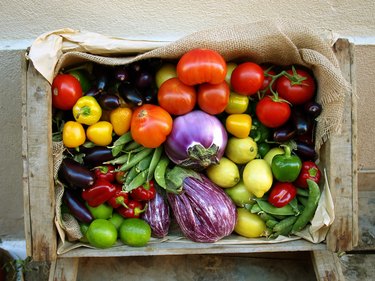
Developing healthy eating patterns takes time. In the case of the Fat Smash Diet Phase 1, it starts with nine days of detox from junk foods and anything that doesn't fuel your body with nutrients.
Created by Dr. Ian Smith, author of a book by the same name, the Fat Smash diet is a 90-day program with four phases. It's designed not only to overhaul your diet, but also to build healthy, sustainable habits.
Video of the Day
Video of the Day
Dr. Ian’s Diet Detox
Phase 1 is the most restrictive of the four phases. You'll be eating mostly produce and are prohibited from eating many of the foods you might be used to eating.
In the Fat Smash Diet Phase 1, you'll eliminate meat, poultry, seafood, cheese, nuts, fried foods, refined sugars and processed carbohydrates, such as bread and pasta. Avoid alcohol, regular soda and caffeine, including coffee and black tea.
Along with Dr. Ian's diet detox, you'll also incorporate 30 minutes of aerobic exercise for at least five of the nine days in the Fat Smash Diet Phase 1. This recommendation is in line with the Physical Activity Guidelines for Americans, which call for 150 minutes of moderate-intensity physical activity per week.
To prepare for the Fat Smash Diet Phase 1, stock your pantry and fridge with the following allowed items:
- Fruits, except avocados
- Vegetables, except white and red potatoes; they should be raw or lightly steamed or grilled
- Extra virgin olive oil
- Vegetarian protein, such as low- or nonfat yogurt, beans and tofu
- Brown rice
- Grains, such as unsweetened oatmeal, grits, cream of wheat or farina
- Up to four egg whites daily
- Herbal or green tea
- Herbs and spices
- Pickles (optional, maximum of two pickles daily)
- Low-fat dressing (optional)
- Artificial sweetener (optional)
- Whole-kernel popcorn (optional)
- Unlimited water
Read more: Recommended Amount of Cardio Exercise
Cut the Cravings
Although you'll be cutting out many familiar foods, you'll also be freeing yourself of cravings. After nine days (or longer, if needed), you may find you no longer want to reach for the nearest bag of chips when you get hungry.
Instead, you might prefer foods that fuel your body, giving you sustained energy for physical activity and daily living. That's partly the goal of Dr. Ian's diet detox — to help shift your attitude about food and exercise, to the point where it becomes a lifestyle.
After Phase 1, you will gradually start adding foods back into your diet. Meanwhile, you will also increase physical activity in Phases 2, 3 and 4, working your way up to one hour of exercise, five times a week. That includes strength training, also recommended by the Physical Activity Guidelines, which advises training all major muscle groups at least twice a week.
Control Your Portions
Note that the Fat Smash Diet promotes portion control — that is, eating smaller meals that satisfy hunger, every three to four hours. Because they are nutrient-dense and low-calorie — aka low-energy-dense — the foods included in the Fat Smash Diet Phase 1 will help you achieve satiety without overeating.
There are different tricks you can use to get in the habit of portion control. One strategy is to use a portion-control plate that provides rough guidelines for how much food you should be eating.
Another method is to measure and portion out servings ahead of time, then keep them on hand in the fridge for easy access. Making food at home will help you avoid overeating at restaurant, where portion sizes are often enough for two or more people. It'll also allow you to know exactly what's going in your food, so you won't eat any of the disallowed items in Phase 1.
Focus on Whole Foods
July 2014 research published in the International Journal of Obesity also encourages a diet of low-energy-dense foods. Eating this way will help you consume satisfying portions while managing your body weight. It will also keep you in step with the 2015-2020 Dietary Guidelines for Americans, which recommend focusing on nutrient density, amount and variety.
Likewise, the Fat Smash Diet is not unlike many other diets that recommend focusing on whole foods and eliminating anything overly processed.
For example, the DASH diet (or Dietary Approaches to Stop Hypertension) is a lifelong approach to healthy eating that reduces sodium intake in order to lower blood pressure, explains the Mayo Clinic. Like the Fat Smash Diet, the DASH diet also encourages eating a variety of nutrient-rich foods.
The bottom line: Meeting your nutrient needs within your calorie limits will help you lose or maintain weight while creating a healthy lifestyle.
- U.S. Department of Health & Human Services: "Physical Activity Guidelines for Americans"
- National Center for Biotechnology Information, U.S. National Library of Medicine: International Journal of Obesity: "What Is the Role of Portion Control in Weight Management?"
- Office of Disease Prevention and Health Promotion: 2015-2020 Dietary Guidelines for Americans: "Key Elements of Healthy Eating Patterns"
- Mayo Clinic: "Dash Diet: Healthy Eating to Lower Your Blood Pressure"
Was this article helpful?
150 Characters Max
0/150
Thank you for sharing!
Thank you for your feedback!